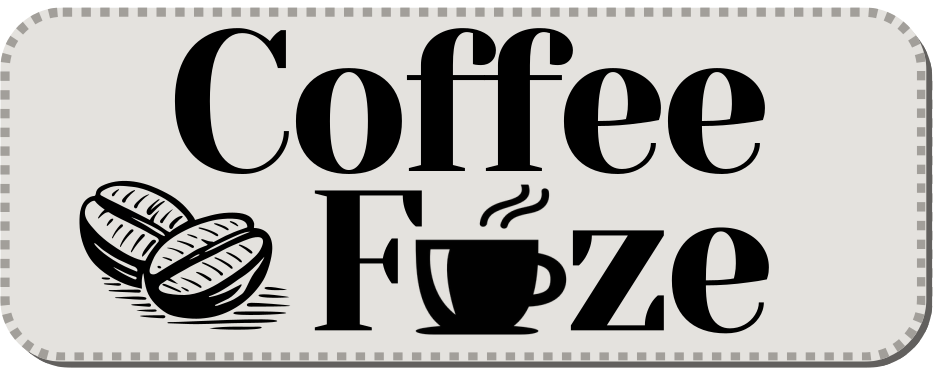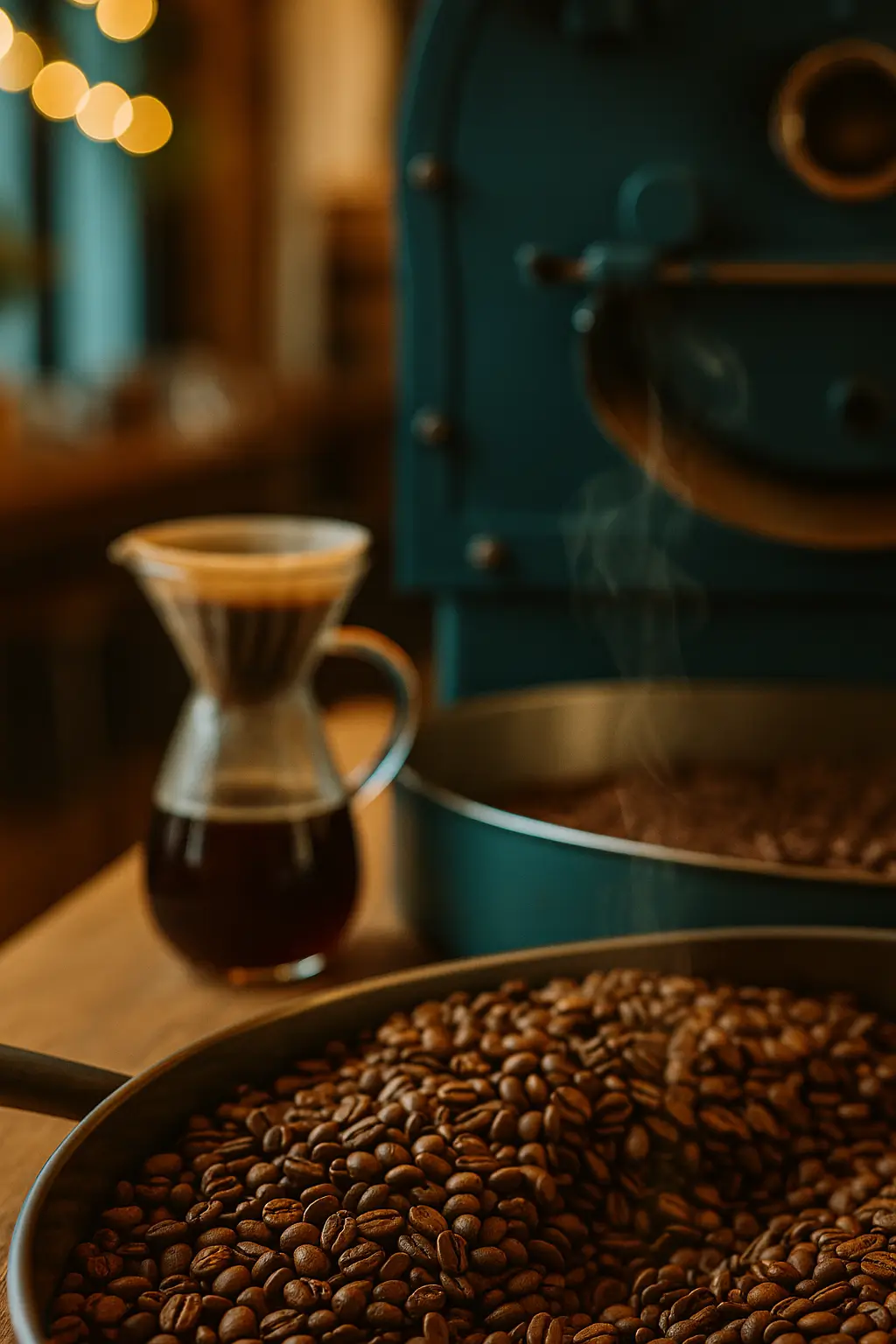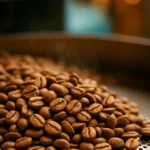Medium roast coffee is a versatile middle ground. It sits right between light and dark roasts. You get a perfect mix of the bean’s natural taste and the flavors that roasting brings out. People love its balanced, rounded profile. This guide explores its unique roasting process, distinctive taste, surprising caffeine content, and best brewing methods.
- What is medium roast coffee: Definition and appearance?
- What is the distinctive flavor profile of medium roast coffee?
- How does medium roast coffee compare to other roasts: A comparative overview?
- What is the caffeine content in medium roast coffee: Debunking myths?
- What are the best brewing methods to highlight medium roast qualities?
- Why is medium roast coffee a popular choice for coffee enthusiasts?
What is medium roast coffee: Definition and appearance?
Medium roast coffee heats to 410-430°F (210-220°C). This temperature turns the beans medium brown, but they stay dry. No oily sheen appears. The “first crack” in roasting is key for this level.
What defines the roasting process for medium roast coffee: Just beyond the first crack?
Medium roast coffee goes past the “first crack.” But it stops before the “second crack.” This exact timing allows sugars to caramelize inside the green coffee beans. It keeps dark, smoky notes from taking over the bean’s natural taste.
This careful method creates a balanced taste. You get fruity, acidic notes from the original bean, like in light roasts. But you also taste sweeter, more developed flavors from reactions like the Maillard reaction.
What are the visual cues of medium roast coffee beans: Color and surface?
Medium roast coffee beans have a clear medium brown color. Their surface stays smooth. You won’t see much oil, if any. This lack of oil sets them apart from darker roasts, which often look shiny.
Sometimes, wet-processed beans show a white stripe in their central crack. This stripe comes from caramelization, a key part of how flavor develops during roasting.
What is the distinctive flavor profile of medium roast coffee?
Medium roast coffee offers a balanced, well-rounded taste. It bridges the gap between bright light roasts and bold dark roasts. You’ll find a good mix of sweetness, mild acidity, and moderate roast characteristics.
What symphony of sweetness, nuts, and cocoa does medium roast coffee offer?
Medium roast coffee gives you specific flavors:
- Caramel, honey, and brown sugar notes develop as sugars gently caramelize,
- Hazelnut, almond, cocoa, and chocolate notes often appear, adding richness to your cup.
Does medium roast coffee retain subtle fruity and floral undertones?
Yes, medium roast coffee often keeps subtle fruity notes. Think lemon or berries. Delicate floral or herbal hints like jasmine, lavender, or mint also remain. These small touches make medium roasts different from darker ones, which usually lose such subtle complexities.
How does medium roast coffee achieve balanced acidity and body?
Medium roast coffee has medium acidity. It gives a pleasant brightness without sharpness. This acidity helps create a smooth, rounded taste. The coffee also has a medium to full body. It offers a satisfying mouthfeel that feels substantial but not heavy.
Many people find medium roasts gentler on their stomach because of this balanced acidity. The moderate acidity also helps keep the coffee’s lively character.
What kind of inviting aromas does medium roast coffee possess?
Medium roast coffee has sweet, pleasant aromas. You’ll often smell toasted nuts, rich caramel, and light chocolate. Sometimes, subtle floral or herbal hints appear. The aroma is stronger than light roasts, but less smoky than dark roasts. It’s a nice scent for your senses.
How does medium roast coffee compare to other roasts: A comparative overview?
Medium roast coffee finds a balance between light and dark roasts. It’s a middle ground, taking traits from both. People often pick it for its versatility and wide appeal.
What are the key differences in roasting temperature and time for medium roast coffee?
Roasting temperature and time show the differences between roast levels. Light roast coffee finishes soon after the first crack, at 385–410°F (196–210°C). Medium roast coffee goes a bit past the first crack but stops before the second, between 410–430°F (210–221°C).
Dark roast coffee hits higher temperatures, 430–450°F (221–232°C). It reaches or enters the second crack. This extra heat and time change the beans’ structure and taste a lot.
| Roast Type | Temperature Range | Roasting Stage | Flavor Characteristics |
|---|---|---|---|
| Light Roast | ~385–410°F (196–210°C) | Ends shortly after 1st crack | Bright, acidic, retains original bean characteristics, floral and fruity notes, dry surface, less ‘roasty’ flavor |
| Medium Roast | ~410–430°F (210–221°C) | Past 1st crack, before 2nd crack | Balanced acidity and sweetness, caramelization begins, fuller body, some original flavors retained with added caramel and complexity |
| Dark Roast | ~430–450°F (221–232°C) | Approaching or at 2nd crack | Bold, smoky, toasty, bitter, low acidity, fuller-bodied, oily surface, original bean flavors mostly transformed |
How does flavor evolution occur across different coffee roast levels?
Flavors change as coffee roasts. Light roasts have bright, acidic notes. Medium roasts gain balance and complexity. Dark roasts turn bold and smoky. Light roasts highlight the bean’s original flavors. Medium roasts add caramel sweetness but keep some delicate notes.
Dark roasts change most of the bean’s original flavor. They become roasted, sometimes bitter. This shows how much the roast master shapes your final cup.
What is the caffeine content in medium roast coffee: Debunking myths?
The caffeine content in medium roast coffee is much like light and dark roasts. This busts the myth that darker roasts have more caffeine. The difference across roast levels is tiny, usually just 3 to 6 mg per 8-ounce cup.
For example, an 8-ounce cup of medium roast coffee, brewed with the same amount by weight, has about 176 mg of caffeine. A light roast might have around 179 mg. A dark roast contains about 173 mg, according to USDA studies. These small variations show that roast level does not change coffee’s stimulating power much.
Why does measurement by weight matter for caffeine content in medium roast coffee?
Measuring by weight affects caffeine content more than the roast level itself. Other things impact your cup’s final caffeine level much more. These include:
- The specific bean type,
- Your chosen brewing method,
- The overall serving size.
For example, a finer grind or longer brew time can pull out more caffeine. This happens no matter the roast. When you measure coffee by volume, lighter roasts are denser. They weigh more per scoop. So, if you measure by volume, you might get more caffeine. Measuring by weight gives you a more accurate way to compare caffeine across different roasts.
What are the best brewing methods to highlight medium roast qualities?
To highlight medium roast qualities, try these brewing methods: pour-over, drip coffee makers, French press, and cold brew. These techniques bring out the balanced taste, mild fruit, and delightful nut and chocolate notes. They also highlight the moderate acidity. Using the right method improves the coffee’s natural characteristics.
How can precision brewing methods like pour-over and drip coffee enhance medium roast coffee?
Pour-over and drip coffee makers are great for medium roast coffee. They let you control the brewing process precisely. Use a medium grind. Heat your water to 195°F and 202°F (90-94°C). This helps pull out subtle fruity and nutty flavors. It makes a clean, nuanced cup.
Why is full-bodied immersion with a French press ideal for medium roast coffee?
A French press is perfect for medium roast coffee. It pulls out complex flavor and body without bitterness. This method makes a smooth, full-bodied cup that shows off the roast’s richness. Full immersion captures more of the coffee’s natural oils and solids. This gives you a satisfying mouthfeel.
How does cold brew unlock smooth and sweet qualities in medium roast coffee?
Cold brew brings out smooth, sweet qualities in medium roast coffee. You steep coarsely ground beans in cold water for 12-24 hours. This low-temperature process creates a mellow, naturally sweet cup. It has very mild acidity. The result is a refreshing, smooth concentrate. Drink it as is, or dilute it to your taste.
Why is medium roast coffee a popular choice for coffee enthusiasts?
Medium roast coffee is a popular choice for many reasons. It offers great balance, versatility, and broad appeal. It blends the bright, subtle notes of light roasts with the comforting, developed flavors of dark roasts. If you like complexity without extremes, this is a great pick.
Its balanced flavor, pleasant smell, and accessible acidity make it widely admired. Medium roast coffee always gives you a satisfying, easy-to-enjoy cup.
Have you tried a medium roast coffee yet? Or perhaps you’ll experiment with some of these brewing methods. What’s your favorite medium roast origin, and how do you prefer to brew it?









